
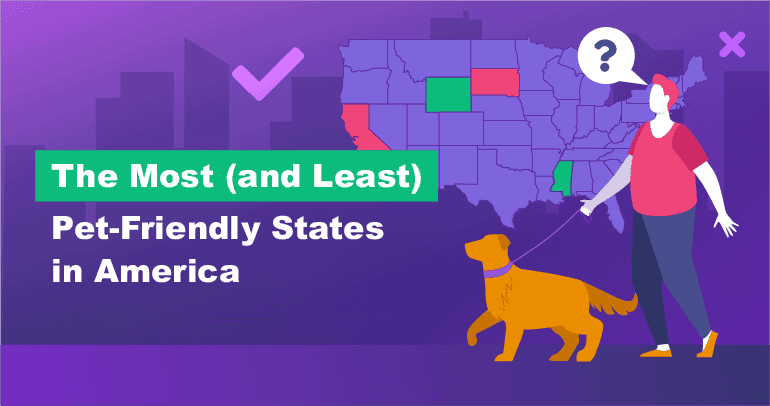
We love our furry friends. There’s no debating that (and I wouldn’t dare challenge a pet owner on their love of Tibbles or Fido). But the question is, does the state you live in love them just as much?
There’s a massive disparity in the value states place on our pets, from the laws that protect them to places willing to welcome them.
To give you the lowdown, I’ve sifted through the datasets and pulled together an ultimate list of the most (and least) pet-friendly states in the US.
I’m not saying you need to move to these states or move out of them. But bear these factors in mind if you are moving or considering getting a new family member. It’s essential you know the laws and the lifestyle your pets will be getting — and how best to care for them wherever you are.
How Many People Own a Pet in the US?
A lot! At the time of writing, there are more than 332,422,000 people in the USA. According to the American Veterinary Medical Association’s (AVMA) US pet ownership statistics, nearly 40% of those people own dogs, and 25% own cats.
When you consider that nearly half of Americans own a dog, you can see why living in a pet-friendly neighborhood is pretty important.
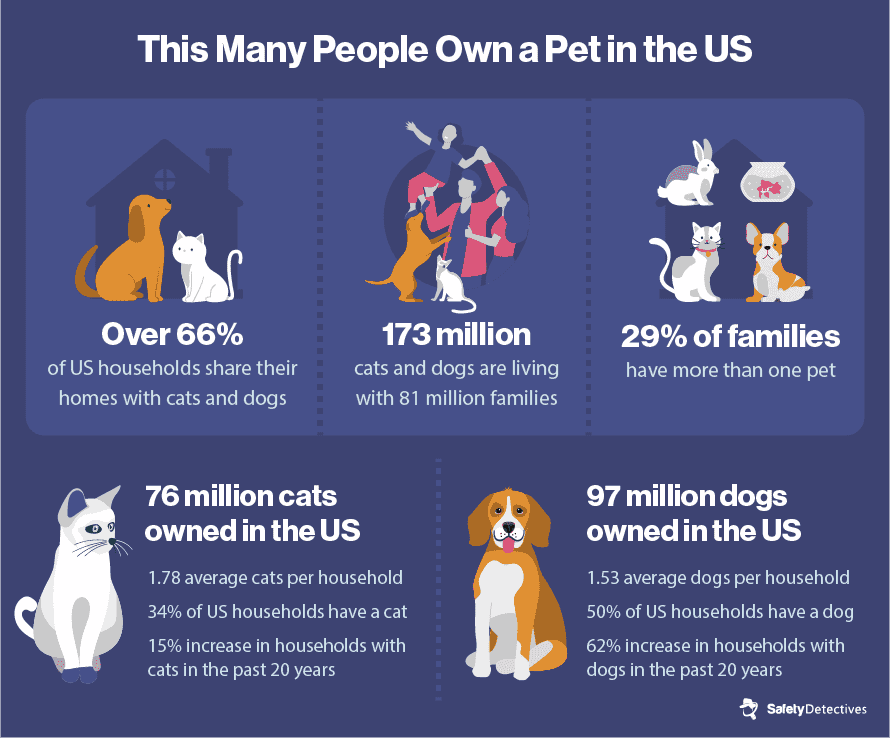
But we’re not limited to just cats and dogs.
Sure, they’re the top contenders when we’re looking for a pet, but it seems we’re partial to some other species too. Fish and birds come in third and fourth place respectively.
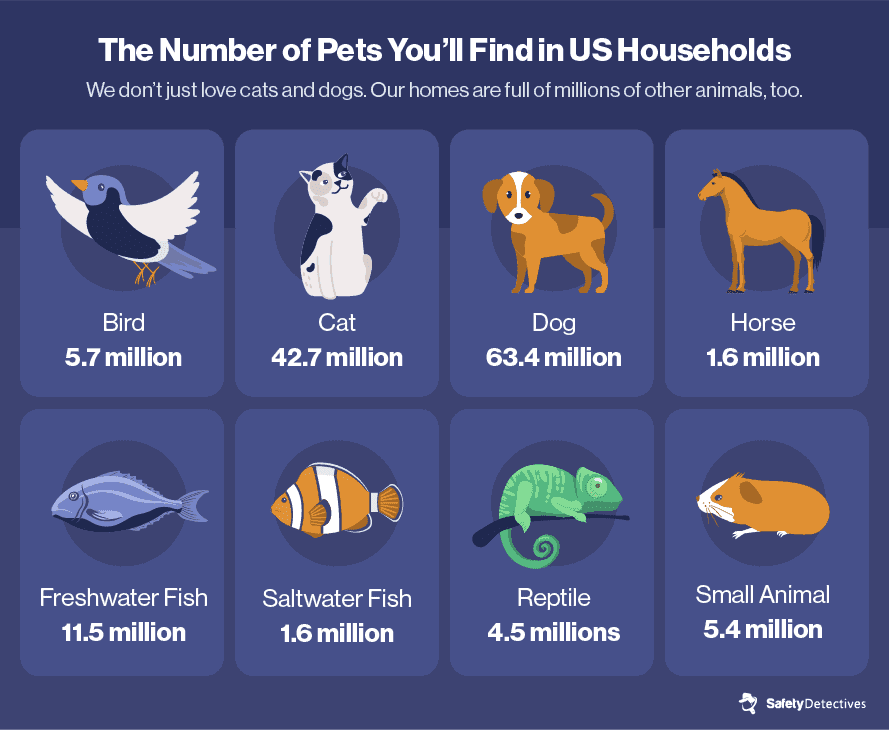
Methodology
To put together this study, we ranked each state based on several factors: 1 being the best and friendliest state and 50 being the state with the most room for improvement.
We removed Alaska and Hawaii from our final results because not all datasets included these states.
To come to that final ranking, we looked at 4 key categories: pet ownership (%), the amount of no-kill shelters (%), the number of pet-friendly apartments and houses available (as a percentage of the total properties available), and the state’s ranking by the Animal Legal Defense Fund for its animal protection laws.
Let’s take a look at what those categories mean in more detail.
Pet Ownership
Using the most up-to-date pet ownership statistics from the American Veterinary Medical Association reports, we were able to rank each state based on the percentage of people who owned a pet.
Those states with the highest pet ownership were considered more accommodating to pets. You know that if you take young Fido along to the nearest park, you’re likely to bump into a friend here or there. You can be safe in the knowledge that you’re surrounded by pet lovers just like you.
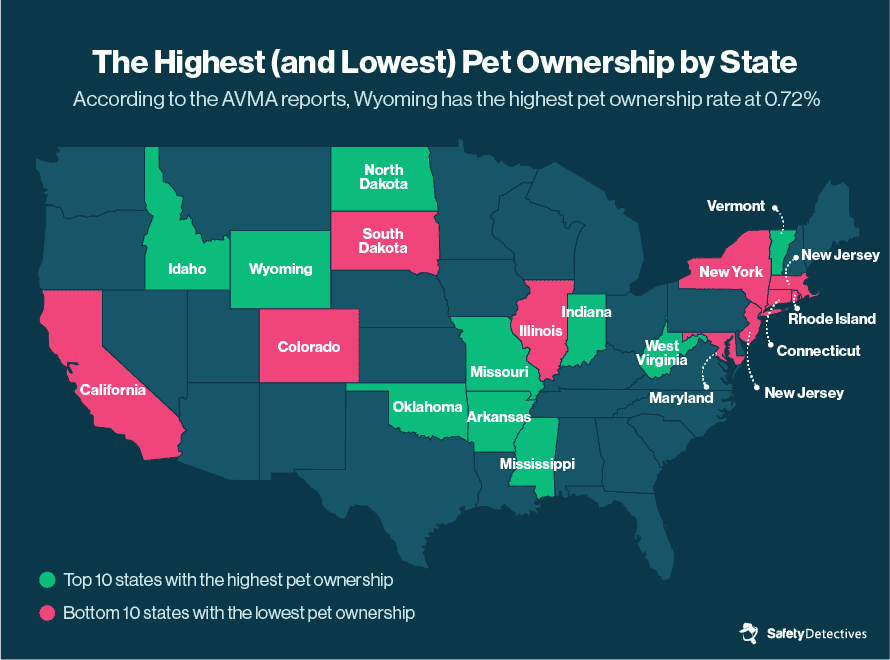
Number of No-Kill Shelters
Simply put, a no-kill shelter ensures that animals placed in their care are not killed. It is important to flag that there is no governing body that determines what a no-kill shelter is. However, it is widely agreed upon that to hold the no-kill status, a shelter must achieve a 90% placement rate — a percentage that has increased over the years. That means that for every 10 animals placed in the care of the shelter, at least 9 of them will survive and get rehomed.
What’s the catch? No-kill doesn’t equal no euthanasia. The remaining 10% covers those animals where humane euthanasia is the kindest solution. It’s not a decision taken lightly, but some animals have serious, untreatable health issues. Some experience chronic pain or have behavioral issues that make them a danger to the community. These animals are sometimes put down. In these shelters, that route is only taken when all other options have been exhausted.
While there is no governing body to regulate no-kill shelters, there are organizations fighting to improve no-kill rates.
The Best Friends Animal Society (BFAS) is fighting to make every shelter in every community a no-kill shelter by 2025. According to them, an estimated 1.5 million cats and dogs were killed in 2016 because shelters couldn’t find safe places to rehome them. In 2020, that number was 347,000.
For this study, as all states vary in population and pet density, we have ordered the states based on their percentage of no-kill shelters.
Of all the shelters in Delaware, for example, 100% of them are considered no-kill shelters. Delaware is the ONLY no-kill state in the US (since 2019), giving it some justified extra points in our study.
There are, however, a few anomalies out there. According to the BFAS, of the 261 known shelters in California, only 100 of them are considered no-kill. But while the state as a whole isn’t looking so healthy, Los Angeles is making great strides and has become the largest no-kill city in the US.
Strength of Animal Protection Laws
Onto the legal issues.
The Animal Legal Defense Fund (ALDF) ranks states based on their overall strengths and weaknesses in the following 5 categories:
- Veterinary reporting of animal cruelty: It may come as a surprise to learn that not all veterinarians are required to report animal cruelty. For many, it is only a suggestion, and some have even discouraged it in the past.
- The ALDF says that only 19 states in the US require vets to report suspected animal cruelty as of 2020.
- A further 31 states allow vets to report animal cruelty.
- Up until 2020, Kentucky prohibited vets from reporting animal cruelty. Thankfully, this has since changed.
- Court-ordered psych evaluations: To find the source of animal cruelty and help rehabilitate offenders, court-ordered treatments are sometimes offered to reduce the risk of repeat offenses.
- 20 states require psychological evaluation and treatment for animal abusers.
- 16 states allow courts to order psychological evaluations of offenders (but this is at the court’s discretion).
- Post-conviction possession bans: If a person has been convicted of animal cruelty, courts in some states can stop that person from owning another animal for a certain time. Placing a ban on these people helps reduce the number of repeat offenses.
- 17 states enforce possession bans after a person has been convicted of animal cruelty.
- 21 states allow possession bans (but it is up to the individual courts whether this is carried out or enforced).
- In 2020, 4 states strengthened their possession ban laws.
- Shelter requirements for animals: When animals are put up for adoption and sent to shelters, the assumption is that those animals will be given the proper access to space, food, and sanitation. However, the requirements vary from state to state.
- 3 states do not have a law that requires pet owners to provide shelter for their animals.
- 9 states have laws that require “necessary” and “proper” shelter.
- 12 states have laws that require shelter that will maintain the health of the animal.
- 22 states have laws that go that extra mile and include the basic requirements we would all expect, like space, ventilation, and sanitation.
- Sexual assault of animals: All but 4 states have laws addressing sexual assault of animals. Even in those that prohibit it, many have outdated and weak laws that are difficult to enforce.
The overall ranking by the ALDF brings all the above factors together and separates states into 3 tiers: a top tier, a middle tier, and a bottom tier.
Since every state has room for improvement, they were placed into tiers based on the number of strengths versus weaknesses. Those placed in the top tier had more strengths than weaknesses and, for those in the bottom tier, the weaknesses outweighed the strengths.
So that’s the legal bit sorted. We then took that overall rank as one of our key measures for the most (and least) pet-friendly states in America.
It might sound all doom and gloom now, but this is serious stuff. We treat our pets like family members, so it’s important to know how the law sees them in certain states.
Percentage of Pet-Friendly Rentals
Using Zillow, we plotted the number of homes and apartments available for rent (in June 2021) that allow small dogs, large dogs, and/or cats. We calculated this as a percentage of all properties for rent.
The higher the percentage of properties that allow animals, the friendlier the state — it’s as simple as that.
10 Most Pet-Friendly States in the US
Based on the criteria laid out above, we believe these 10 states are the friendliest and most welcoming to pets. So without further ado, let’s meet our top 10.
1. Maine — The Most Pet-Friendly State in America
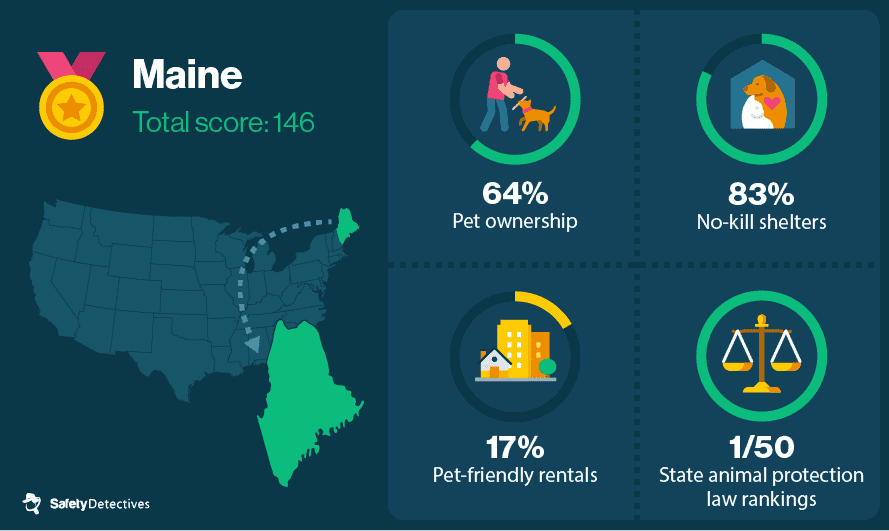
So here it is, America’s pet haven, where 64% of the population have at least one pet — a stat much higher than the national average.
Imagine a place where puppies and kittens cats skip paw-in-paw down the street. They host get-togethers with hamsters and horses at the local off-leash park. Okay, maybe not, but Maine is the closest we’re getting to it, so let me dream.
When it comes to no-kill shelters, Maine is leading the way as one of the top 3 states in the country. Nearly 83% of its shelters hold no-kill status. According to data collected by the BFAS, more than 92% of animals have been saved in shelters. That number has been climbing. And it also has the best animal protection laws in the country overall, to date.
So we know Maine is making strides in saving and protecting animals, but what about day-to-day outings?
BringFido, a leading pet travel site, tells us that 24 off-leash dog parks are dotted around the state. There are also 20 dog beaches, so there’s no shortage of safe places to run around. My top pick? The Little Long Pond leash-free area, where pups can play and paddle in this private area of the Acadia National Park.
2. Vermont — The Home of Dog Mountain, Dog Party, and Dogfest
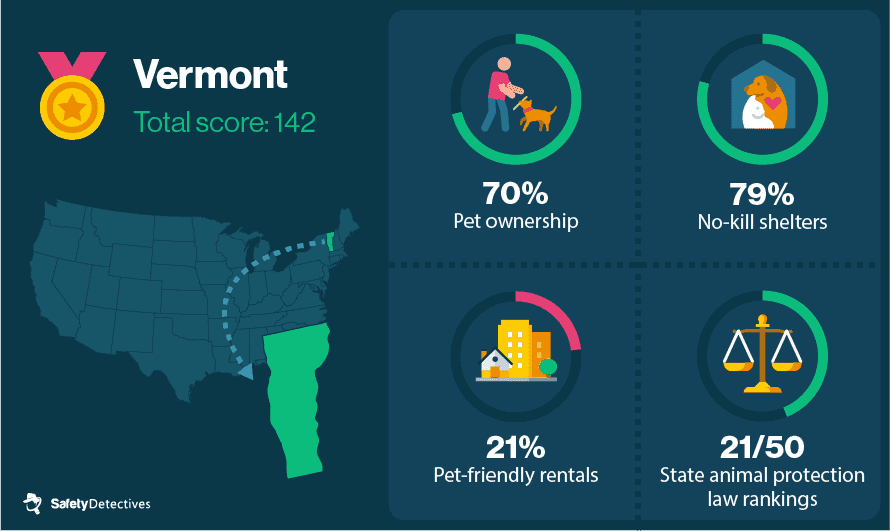
Coming in at number 2 is the green mountain state, Vermont. With nearly three-quarters of Vermonters owning a pet, you’ll be hard pushed to find anyone without a cat or dog by their side or in their home.
If you don’t live in Vermont or plan to move there soon, you’ll find plenty of pet-friendly hotels (more than 1,200). There are plenty of suitable restaurants, too (more than 200) and parks and activities (more than 75).
May I recommend the aptly named Dog Mountain? It’s a 150-acre farm that is now home to swimming ponds and hiking trails. Plus, there’s an unusual art gallery where dogs are the only muse. You’ll also find the only dog chapel in existence where pet owners can come and reflect on pets that have passed on.
Vermont even hosts a series of annual events dedicated to our pampered pooches. These include August Dog Party and October Dogfest, which I will absolutely be attending… with my cats… which should be fine, right?
3. Illinois — A Worthy Third Place Brimming with Pet-friendly Homes & Services
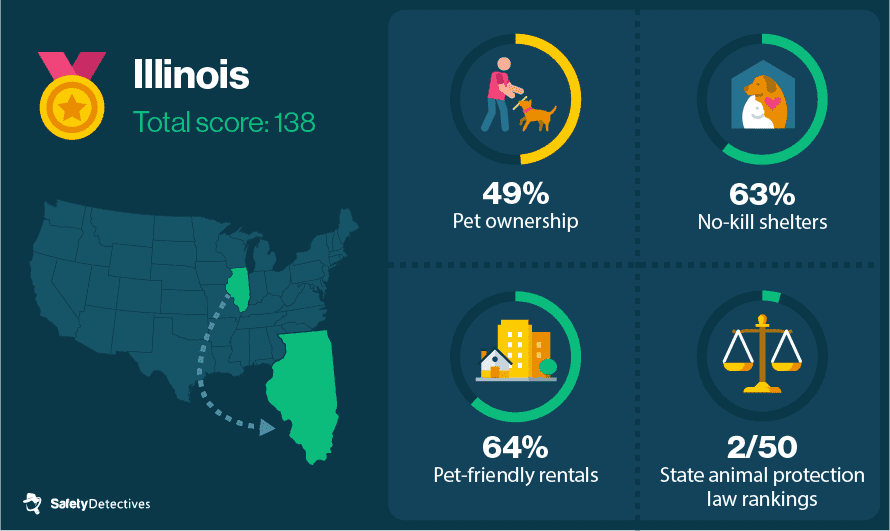
Sticking with the northeast, Illinois scoops the bronze medal.
It’s got the second-highest ranking for rentals that allow pets (3,000 options at the time of writing, and that’s just those that are available now). So, you’ll have no trouble finding a home somewhere that suits you and your four-legged friends. Illinois also comes in second with its animal protection laws, so you know that every animal is cared for.
And if you’re considering moving into the neighborhood, there are more than 605 pet services. From pet sitters to doggie daycare and groomers, Illinois has got you covered.
4. Washington — A Green, Hiking Haven for Animals & Pet Owners
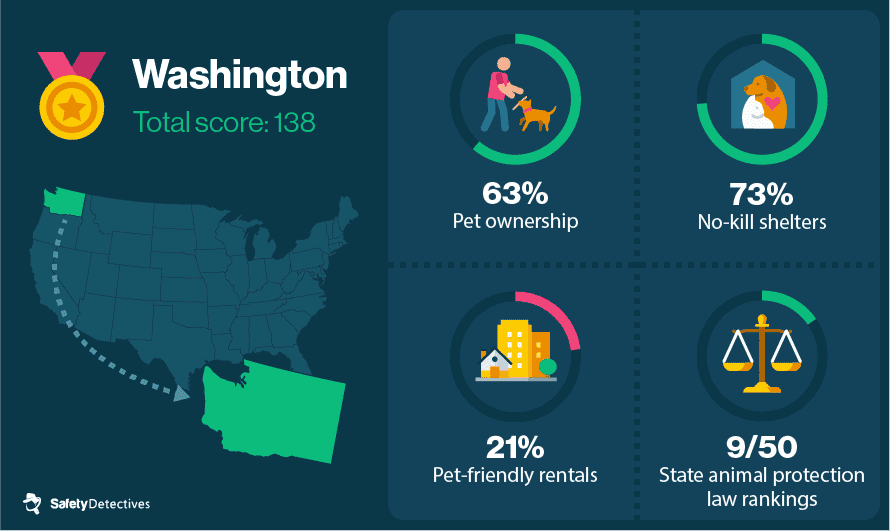
Hopping over to the most northwestern finalist, in fourth place, is Washington state.
Also known as “The Evergreen State,” its abundance of lush green forests and coastal beaches make it an animal’s dream destination. If they’re allowed to roam freely, that is. Thankfully you’ll find hundreds of dog-appropriate hiking trails. There are also plenty of beaches and parks across the state, from Discovery Park in Seattle to Kalaloch Beach in Forks.
The protection laws are strong, the pet ownership high, and the number of animals being put down unnecessarily is decreasing year on year.
5. Indiana — A Welcoming State with Nearly 70% Pet Ownership
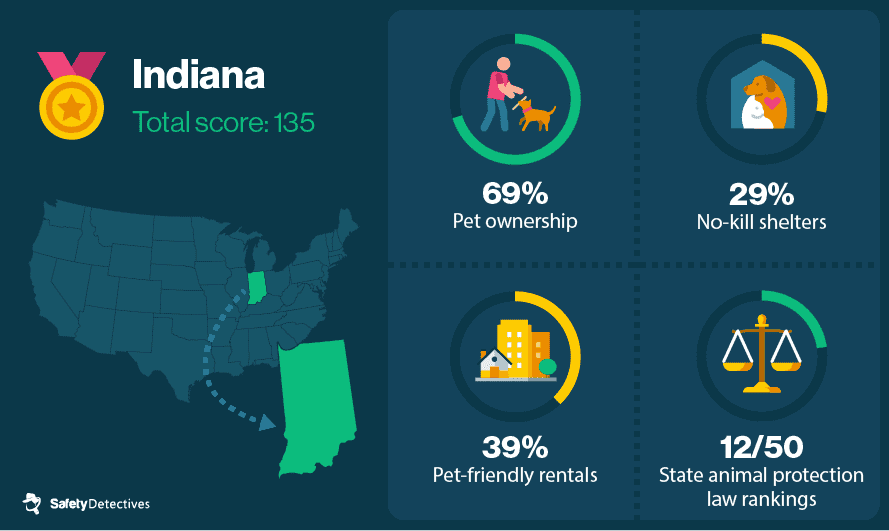
Sneaking into the top 5 is Indiana, with one of the highest pet ownership rates in the country. It’s got satisfactory animal protection laws and nearly 1,000 pet-friendly restaurants to choose from.
And it’s not just restaurants that will pull up a chair for your four-legged friends. More than 1,000 hotels, vacation rentals, and campgrounds encourage you to bring your pets.
6. Missouri — A Nearly No-Kill State and the Home of DogtoberFest
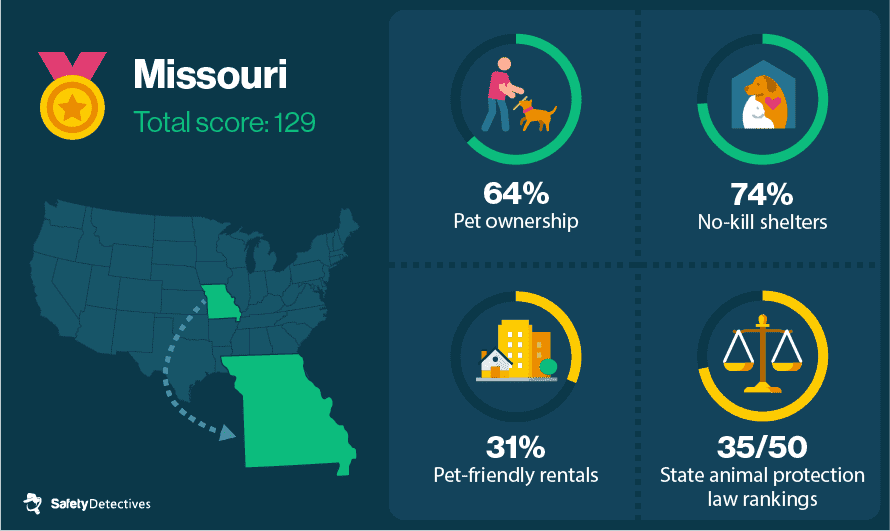
Missouri is well on its way to becoming a no-kill state by 2025, with a total save rate of just under 90% already.
If you’re a Missouri resident, make sure you visit DogtoberFest at the Kemper Outdoor Education Center in Blue Springs on the edge of Fleming Park. You can get in for free if you donate dry or canned dog food to support local animal shelters.
If you’re not a local, but you still want to get involved, there’s no shortage of pet-friendly rentals in Blue Springs or nearby Kansas City.
7. Kansas — An Up & Coming Pet-friendly State with No Shortage of Dog Parks
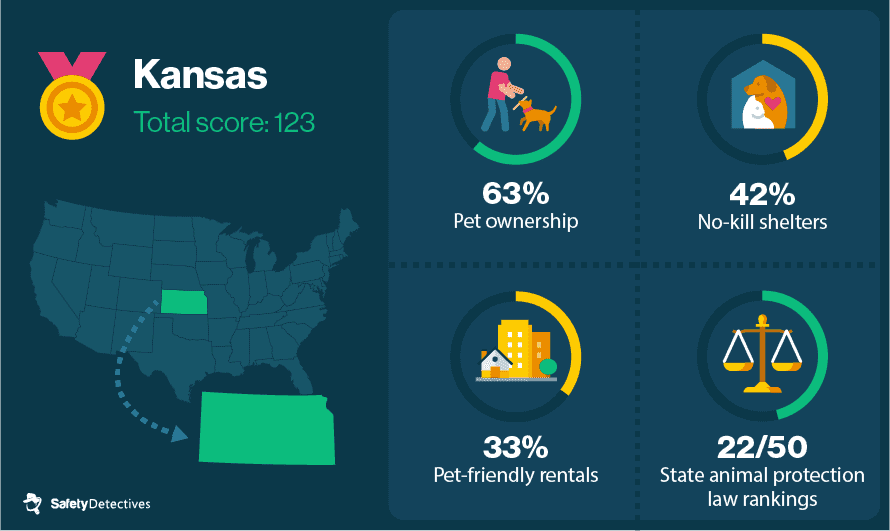
Kansas comes in at number 7 for its high percentage of pet ownership (63%) and pet-friendly rentals.
It’s got some work to do, as does every state, but its animal laws seek to protect pets from animal cruelty. Immunity is given to someone rescuing an animal from a hot car (which is not the case in every state).
There’s no end of dog parks around the state, from Heritage Park in Olathe to Shawnee’s Mission Off-Leash Dog Park. Hotels will welcome you and your pets with open arms, and nearly 500 restaurants are listed as pet-friendly on BringFido.
8. Oregon — The State With the Most Dog Parks in the Country
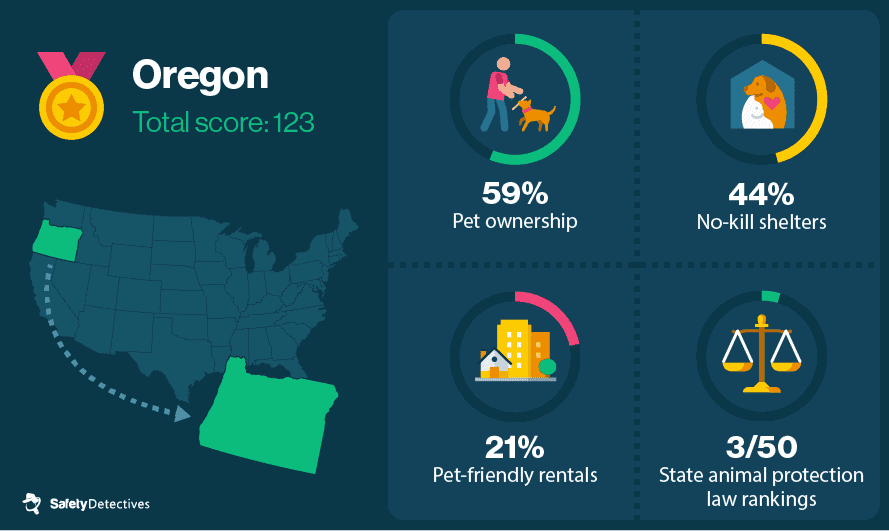
Oregon scored consistently well across the board in our test. It has some strong animal protection laws and a high percentage of no-kill shelters. Plus, many of its counties already meet the criteria for no-kill. In fact, the number of animals killed in Oregon is in the hundreds rather than the thousands.
According to the Trust for Public Land, Oregon has more dog parks than any other state per capita. This is thanks to Portland, which has 35 dog parks alone — that’s 5.4 per 100,000 residents.
9. Colorado — A Consistently Strong & Safe State for Pets
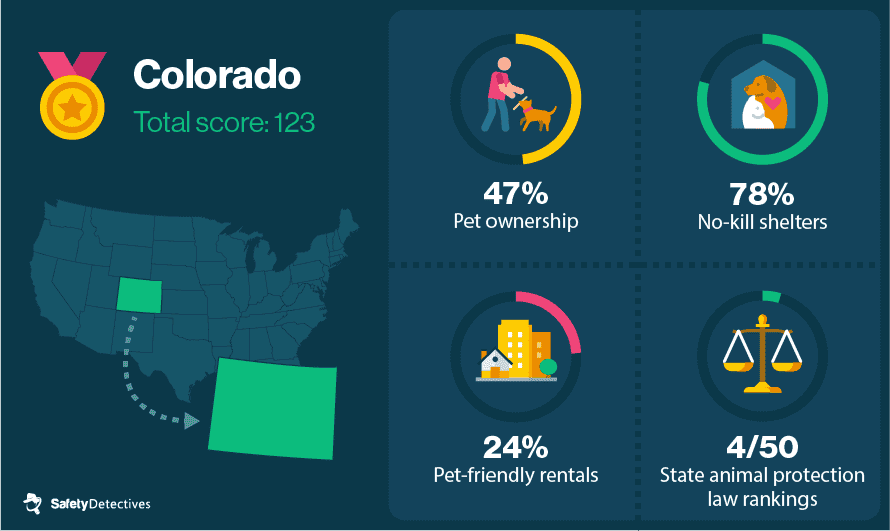
Colorado makes the top 10 for many reasons. The number of no-kill shelters is above average, and its animal protection laws rank among the top 5 states.
But it doesn’t stop there, as it continues to improve its laws year after year. In 2020, the state banned killing contests for foxes, coyotes, and other small animals. In 2019, it passed a new possession ban law for convicted animal abusers.
Denver has 1.8 dog parks per 100,000 residents and one of the highest veterinarian employment rates for a metropolitan area. If you want the buzz of city life but aren’t sure whether it’s right for your whole family, think again — Denver might be the solution.
10. Florida — Dog Parks & Vets Abound
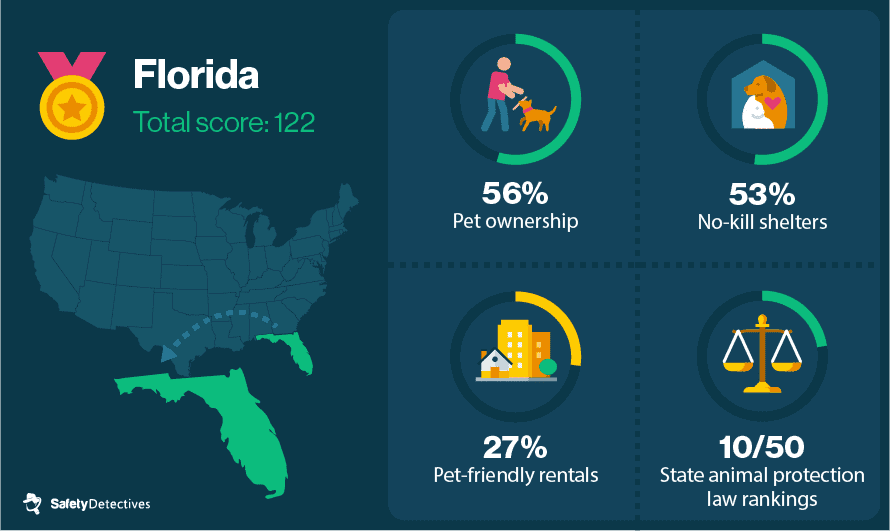
In the Trust for Public Land’s study on the number of dog parks per capita in the 100 largest cities in the US, Tampa came in fifth. That’s an incredible 4 dog parks per 100,000 residents.
According to the US Bureau of National Statistics, Florida also has the third-highest employment rate of veterinarians in the country.
When it comes to no-kill shelters, Florida has some work to do. The number of cats and dogs killed is decreasing yearly, and more cities are being classed as “nearly no-kill,” which is a step in the right direction.
10 Least Pet-Friendly States in the US
It’s important to remember here that we’re not saying to round up your cats (good luck trying that), get your dogs back on their leads, and run from these states. As we explained in our methodology, every state has some work to do.
No one’s got it spot on yet, but some states need a little more encouragement and time to fix themselves up. Whether it’s to do with the strength of their laws or their lack of no-kill shelters, these states need to make some changes.
1. South Dakota
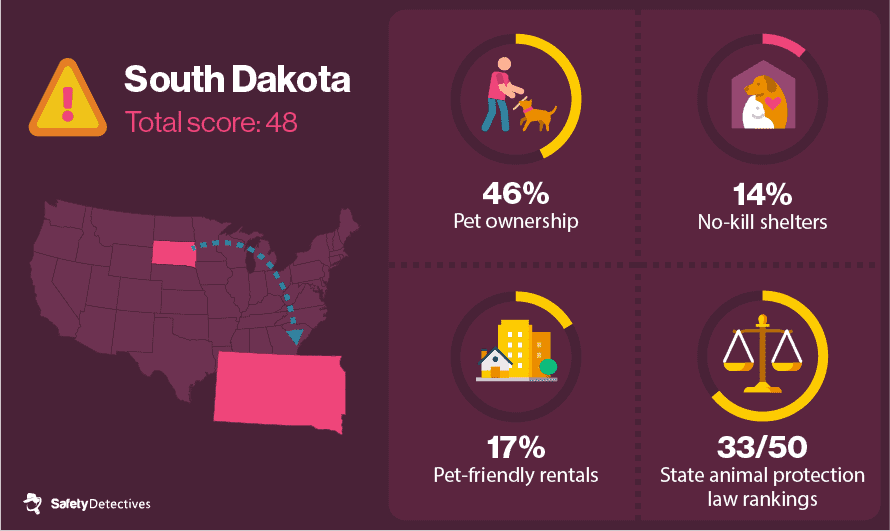
South Dakota tops our list of the least friendly states for a few reasons.
Only 14% of the population own pets, so you’re not as likely to see and meet as many cats and dogs on your travels. Equally, you won’t find as many pet-friendly apartments or houses to rent.
Its animal protection laws aren’t necessarily the worst in the country, but, as you’ll find with this top 10, South Dakota has a lot of work to do. Currently, vets are not required to report suspected animal cruelty, and neglect or abandonment of an animal is not a felony. Only 14% of the state’s shelters are considered no-kill.
2. Maryland
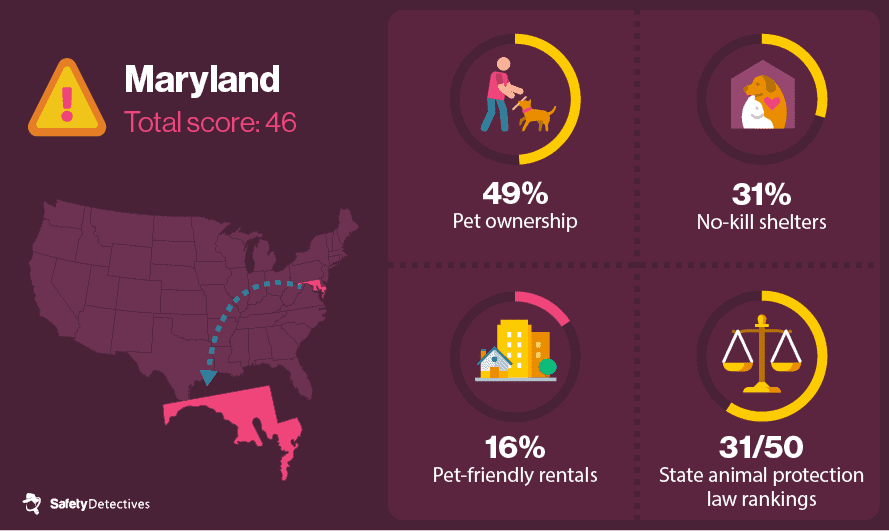
Maryland tells a similar story. Pet ownership is just under 50% (around the national average), but neglect and abandonment of animals is not a felony — something many of us would expect as standard.
If you were thinking of moving to Maryland, your choices of pet-friendly homes to rent would be fairly limited. Yet, there are plenty of hotels and restaurants that will welcome pets.
3. Nebraska
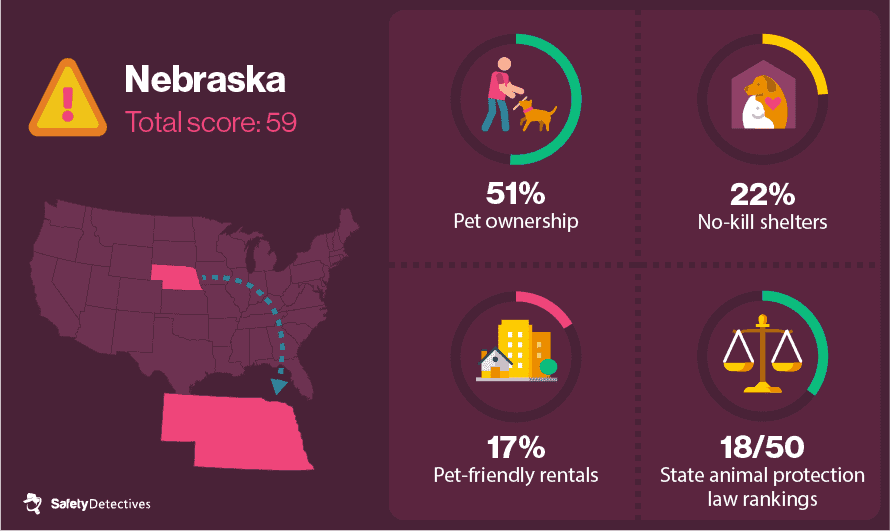
Less than 22% of Nebraska’s shelters are considered no-kill, less than 17% of rentals are pet-friendly, and there’s no law or ban against leaving animals in parked vehicles. There are no laws or regulations against tethering animals either, leaving Nebraska with plenty of work to do.
4. Louisiana
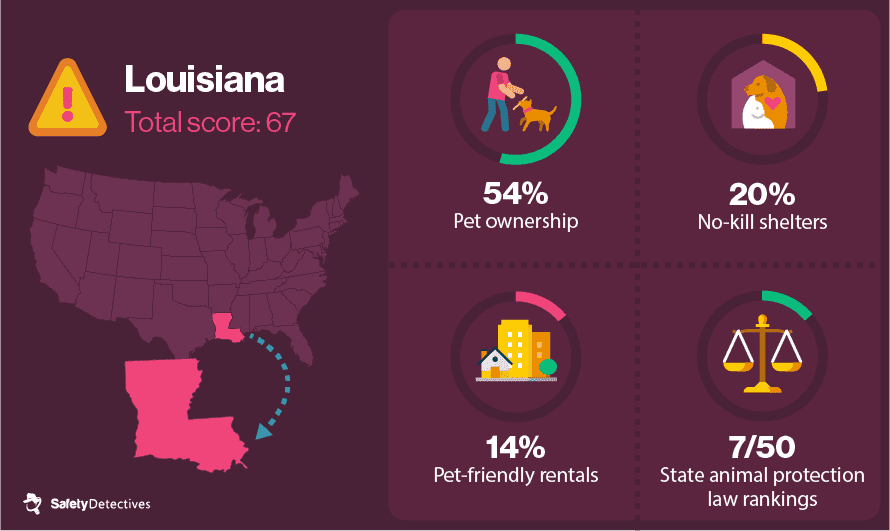
BestFriends.org lists Louisiana as a high-priority state, too, with more than 15,000 pets killed in recent years and a save rate of only 72%. Thankfully, this number is increasing, but it’s a long way behind many other states.
Louisiana redeems itself in part thanks to its abundance of pet-friendly hotels. This makes us think that maybe this is a place to visit with your pet, rather than live. There’s plenty of hiking trails and dog parks if you do pop by.
5. New Mexico
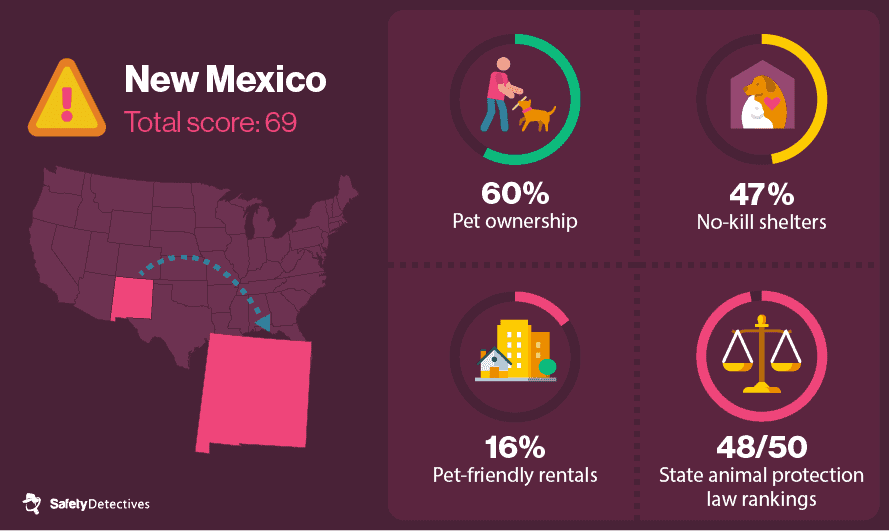
New Mexico makes this list for having the most work to do regarding animal protection laws. The ALDF ranked the state at the very bottom of its bottom tier.
New Mexico’s laws do not provide adequate definitions of the standard of basic care for animals. There are also no provisions for the abandonment or neglect of animals. There’s no possession ban for people convicted of animal cruelty and no law against sexual assault on animals. We’ll let you digest those facts…
6. New Jersey
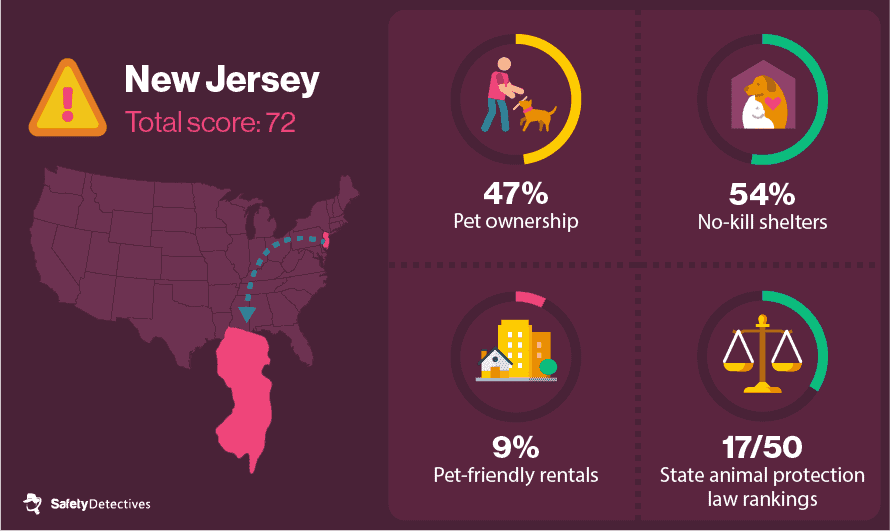
One of the things that lets New Jersey down is that veterinarians are not required to report suspected animal cruelty. While its animal protection laws are not the worst in the country, many of the states on this list have this law covered in their constitutions.
Aside from this, New Jersey is also in the bottom 5 of pet ownership rates in the country. It’s not the end of the world, of course. However, the more pet-owners living in a state, the more you’ll meet — and the more people have deemed it a suitable home for them and their animals.
7. Connecticut
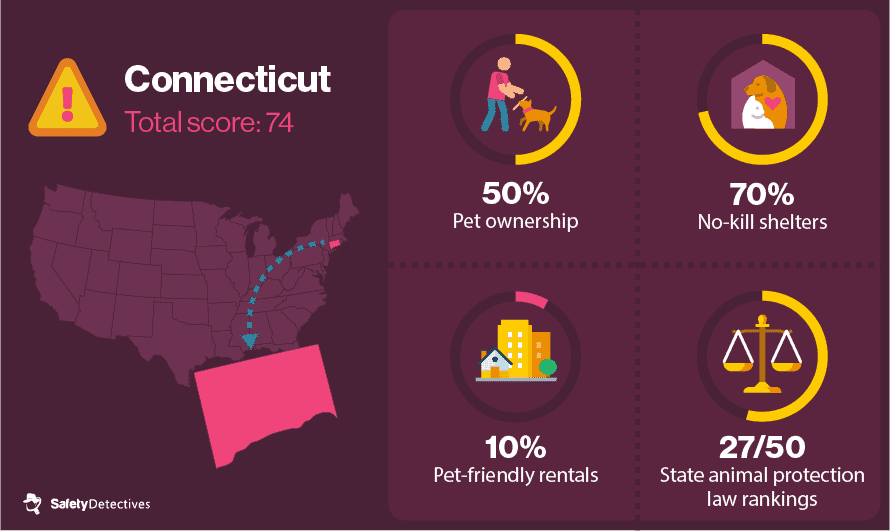
In fairness to Connecticut, it’s up there when it comes to no-kill shelters, so we can’t knock them for that. 281 animals were killed in shelters in recent years, according to BestFriends.org, compared to the thousands in other states. However, this number has increased.
When it comes to finding a home, only 10% of rented houses and apartments will allow you to move in with your pet. That means your options are considerably reduced if you plan to move.
With 47% pet ownership in Connecticut, that’s nearly half of the population trying to find a suitable home in 10% of properties (not taking into account homeowners, of course).
8. Alabama
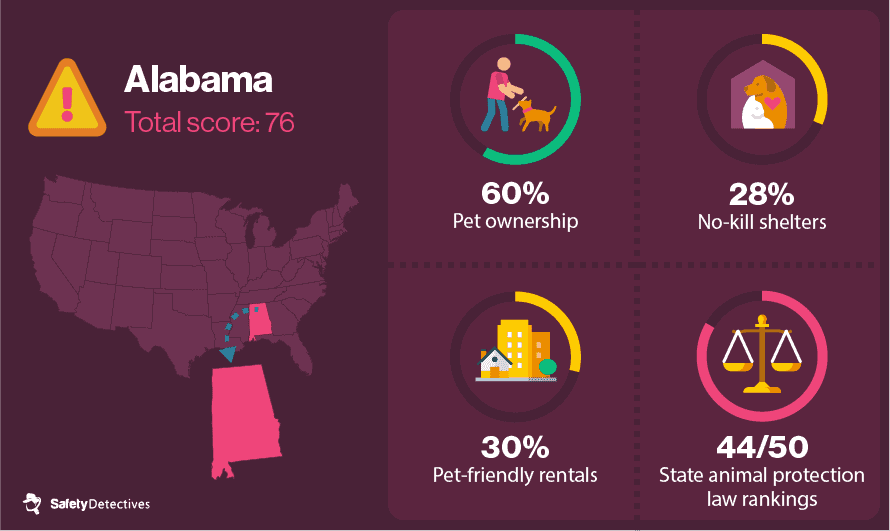
Alabama is another high-priority state when it comes to no-kill shelters. Only 30% of its shelters meet the no-kill threshold of saving 90% of animals. The state’s overall save rate is just under 75%.
It’s also one of the 27 states with no laws or bans on tethering animals whatsoever. It has no rescue laws for animals left in parked vehicles either. In fact, its animal protection laws are some of the weakest in the country. It’s not a felony to abandon an animal, and there’s no requirement to report suspected animal cruelty.
9. California
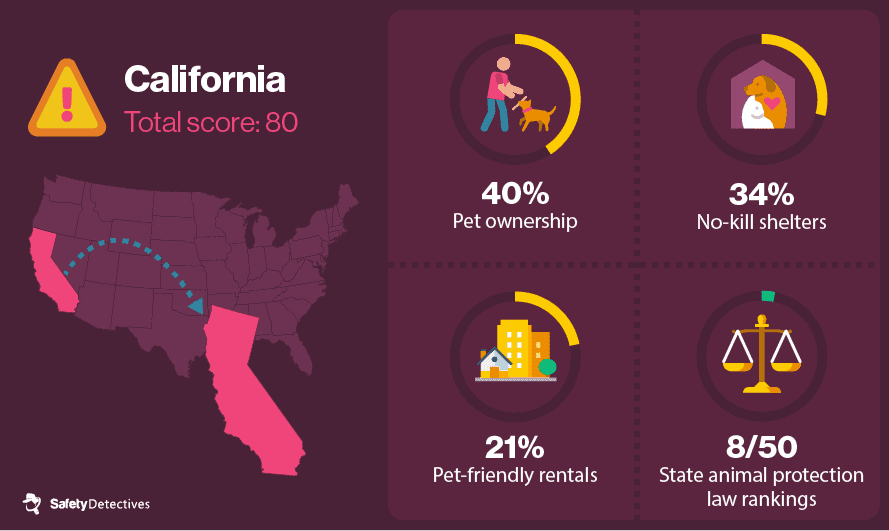
California might seem like a surprising addition to this list, and I want to clarify that it’s not all bad.
As a state, there’s work to do. But if we single out cities like Los Angeles, there are some real anomalies. LA is now the country’s biggest no-kill city.
Yet, as a state, California is listed as a “top priority for change” on Bestfriends.org. While the number of animals killed has fallen dramatically, it is estimated that nearly 40,000 pets have been killed in recent years.
10. Georgia
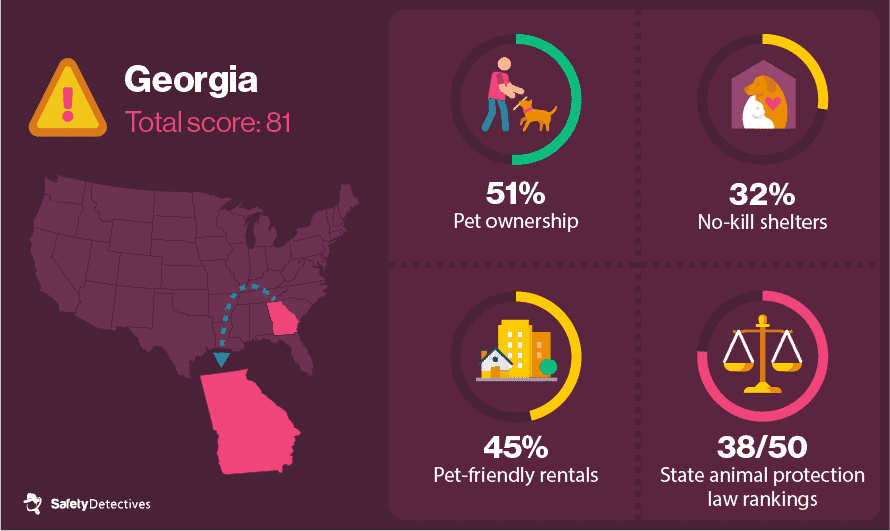
Georgia is improving year on year, but we’ve still seen the unnecessary deaths of nearly 15,000 pets recently. With only 32% of shelters no-kill shelters, these numbers remain high.
And this is not helped by the lack of laws for tethering and rescuing animals from parked vehicles. That being said, pet ownership and pet-friendly rentals are high. So, while the laws do not favor animals, there are plenty of them around!
What Else Makes for a Pet-Friendly Place? Other Factors to Consider
Now, if we could have combined all the data ever collected about pets, pet-related laws, and animal rights issues in every state in the US, we would have. But, if that were the case, you wouldn’t be reading this now. We’d still be drowning in spreadsheets and datasets.
Instead, we picked out what we consider (and what we hope you also consider) the best range of data to make our conclusions.
Aside from our criteria, these are the things you may want to look into if you’re considering getting a pet or moving to a new state with your fluffy friend.
Tethering Laws
Tethering, for most states, means leaving your dog tied or chained to a stationary object. Tethering laws prohibit this from happening for an unreasonable amount of time. Amazingly, as of 2021, 27 states do not have a law against tethering at all.
That means 23 states have laws that control and limit how owners can tether their dogs.
For example, in Massachusetts, no person can tether a dog for longer than “five hours in a 24-hour period and outside from 10pm to 6am.” A first offense will get you a written warning or a fine of no more than $50.
In Maryland, it’s prohibited to “leave a dog outside and unattended by use of a restraint that unreasonably limits the movement of the dog.” Although there is no statement on time, committing this crime can lead to imprisonment of up to 90 days or a fine of up to $1,000.
In California, it is simply not allowed: “No person shall tether, fasten, chain, tie, or restrain a dog to any dog house, tree, fence, or other stationary object.”
Of those states that do have laws limiting or controlling tethering, most stipulate the conditions of the tether. They consider how long the restraint is and how long you can lawfully leave an animal for. This varies from “no longer than is necessary for the person to complete a temporary task” (a sub-note of Californian law) to “no more than 14 hours in a 24-hour period” (Rhode Island).
No animal should be tethered to a post day in, day out. But in nearly half of US states, there is simply no law to stop it from happening.
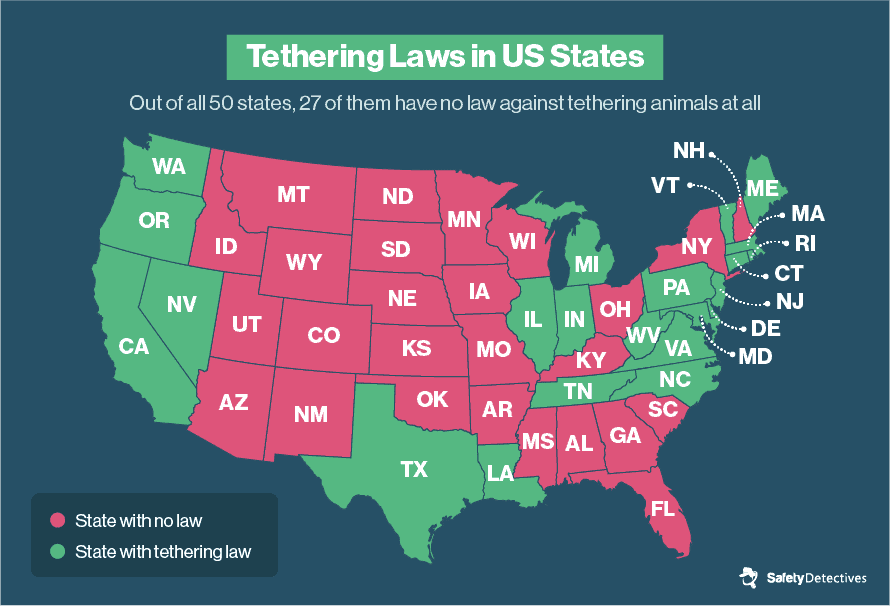
Animals Left-In-Cars Laws
Much the same as with tethering, the law on leaving animals in cars varies from state to state. In 31 states, laws either prohibit people from leaving animals in a confined vehicle or provide people with immunity if you have to rescue an animal from a vehicle.
Animallaw.info tells us that 15 states have brought in laws that will allow any person to “rescue a distressed animal” from a vehicle. Previously, only local enforcement could act.
Those states that don’t allow “anyone” to rescue an animal say that only certain people can do the rescuing. For example, in Arizona, “a peace officer, animal control enforcement agent, or animal control enforcement deputy” may use reasonable force to open a vehicle and save an animal.
In California, those listed above — as well as firefighters and emergency responders — have authorization. These individuals may be best equipped to rescue an animal. But when time is of the essence and an animal is in danger, locating a peace officer isn’t the quickest route.
In Indiana, there is even less incentive to help. The state has become the first to rule that the person who forcibly enters a vehicle to rescue an animal is now liable for one-half of the damage caused to the vehicle. They are immune from criminal or civil liability, but the cost will fall, in part, on them.
The variation in these laws is significant in the hottest states in the US. In these states, temperatures in a confined vehicle reach dangerous levels. Florida, Texas, and Louisiana are often listed as 3 of the hottest states. Each has an average annual temperature topping 70°F / 21°C.
While Florida and Louisiana give people immunity to rescue a distressed animal, Texas has no law whatsoever to protect animals. Or protect people wanting to save an animal.
Out of 50 states, West Virginia and New Jersey are the only 2 that now make leaving an animal unattended and in dangerous conditions a criminal offense.
Puppy Mills
Puppy mills are commercial dog-breeding facilities set up to generate profit, often prioritized over the wellbeing of dogs, and they’re big business in the US. They’re not illegal in America, but there is widespread opposition across the country.
It is estimated that 2.6 million puppies are sold from puppy mills every year and that there are at least 10,000 mills in the US (HSUS), but as many puppy mills are not registered, this number is likely to be much higher.
In puppy mills, dogs are often kept in cramped conditions with very little food and water to keep overheads low and profit high. Female dogs are also bred repeatedly, giving birth to an average of 9.4 puppies in their lifetime with little time between each pregnancy and reports of female dogs being killed when they can no longer reproduce.
So why are these facilities legal? While there may not be any laws to prohibit them, puppy mills must adhere to the 1996 Animal Welfare Act, which sets up minimum care standards. Those that are registered are regulated by the US Department of Agriculture. However, less than 3,000 are actually regulated, and many more operate through loopholes in the law.
What keeps these puppy mills in business is retail stores buying puppies to sell on. While the demand from retail continues, so will puppy mills. However, there is some progress, as a growing number of cities have banned the retail sale of pets.
In 2017, California passed a bill banning the retail sale of pets across the state, and four more states followed suit: Maine, Maryland, Washington, and Illinois, while other states, including New York, have bills pending, but there is still much work to be done.
Pet-Friendly State Parks
Puppy mills are commercial dog-breeding facilities set up to generate profit. They often rank income over the wellbeing of dogs, and they’re big business in the US. Mills aren’t illegal in America, but there is widespread opposition across the country.
It is estimated that 2.6 million puppies are sold from puppy mills every year and that there are at least 10,000 mills in the US. But as many puppy mills are not registered, this number is likely to be much higher.
In puppy mills, dogs are often kept in cramped conditions with very little food and water to keep overheads low and profit high.
Female dogs are bred repeatedly, giving birth to an average of 9.4 puppies in their lifetime. There’s little time between each pregnancy, and there are reports of female dogs being killed when they can no longer reproduce.
So why are these facilities legal? While there may not be any laws to prohibit them, puppy mills must adhere to the 1996 Animal Welfare Act. This sets up minimum care standards, and registered mills are regulated by the US Department of Agriculture. Yet, less than 3,000 are actually regulated, and many more operate through loopholes in the law.
What keeps these puppy mills in business is retail stores buying puppies to sell on. While the demand from retail continues, so will puppy mills.
There is some progress, as a growing number of cities have banned the retail sale of pets. In 2017, California passed a bill prohibiting the retail sale of pets across the state. 4 more states followed suit: Maine, Maryland, Washington, and Illinois. Other states — including New York — have bills pending, but there is still much work to be done.
Dog Parks
According to a Trust for Public Land study, there are 810 dedicated dog parks across America’s 100 largest cities. This number has jumped by more than a third from the previous year. In fact, the study estimates that there has been a 74% increase in the number of dog parks in these cities since 2009. Here are the top 10 you need to know about:
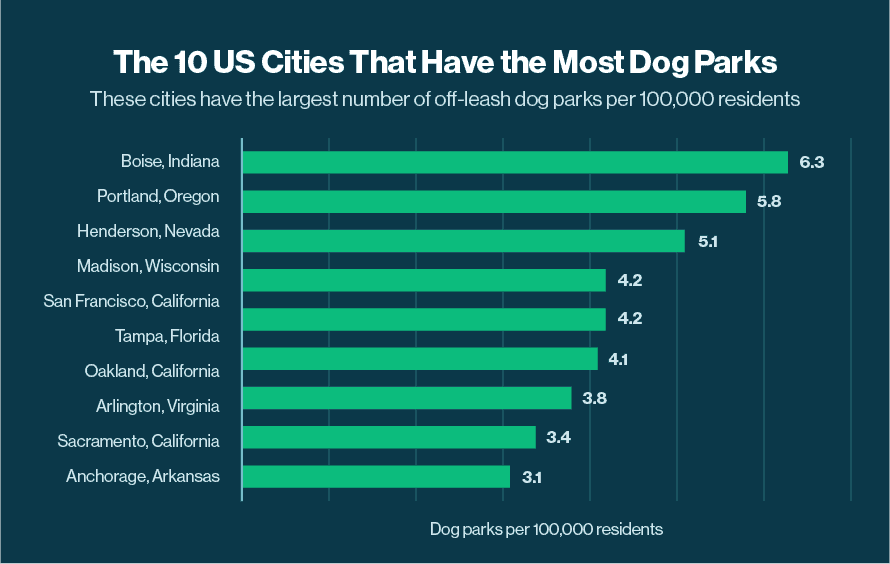
If you’re currently in Boise, Portland, or Henderson, get outside and enjoy the abundance of pet-friendly parks. Or if you were wondering whereabouts in, say, Florida you want to move, knowing that you’re surrounded by dog parks in Tampa might be a factor to consider.
While it didn’t make the top 10, it’s also worth mentioning New York for its 145 dog parks. Sure, close to 9 million people live in the city, but it’s a reminder that city life isn’t just for us two-legged folk. The four-legged among us can enjoy a slice of the action too.
Off-Leash Beaches
Obviously, far fewer states actually have beaches. But if you are lucky enough to live in or are moving to sandy shores, you’ll be interested to know which beaches will welcome you and your fur friends with open arms.
Given how much of the state is lined with sand, it will come as no surprise that Florida is teeming with off-leash beaches (73, according to BringFido).
Sticking with the east coast, New Jersey is a friend to all pups — as is our number one state, Maine.
In the very southeasterly corner of the state, from Kittery Point all the way up to Portland, you’ll find the majority of Maine’s off-leash beaches clustered together.
Honorable Mentions: 5 Most Pet-Friendly Cities in the US
Just because some states haven’t scored that highly in our study doesn’t mean they’re all terrible. In fact, generalizing a whole state for its behavior in a country so vast is a little unfair.
For example, California hasn’t topped the charts as a state, but it’s a whole different story when we single out Los Angeles. In fact, LA is leading the way in becoming the largest no-kill city in the US. Round of applause for LA.
These 5 cities haven’t gone through the rigorous testing that the states above have. But they’ve all managed to catch our eye as we’ve sifted through reams of research. So without further ado, here are our honorable mentions.
1. Portland, Oregon
Okay, so Oregon is already up there in our top 10 states list but largely thanks to Portland.
With 5.4 dog parks per 100,000 people, the second-highest number of dog parks per capita in the country (and second only to Boise’s 5.7), Portland is a pup’s dream destination.
There are more than 400 pet-friendly restaurants. Plus, there are endless hiking trails and enough groomers, trainers, and pet sitters to service the whole city.
2. San Francisco, California
San Francisco is another city helping to redeem California. With 4.3 dog parks per 100,000 people and more than 50 dog meetup groups, dogs are as welcome — if not more than — humans. In fact, according to 2018 census data, San Francisco is home to more dogs than it is children. Yes, really. So if you’re into a more adults-and-dogs-only lifestyle, San Fran has got to top the list.
3. Tampa, Florida
With more than 230 pet-friendly restaurants and 4.1 dog parks per 100,000 people, we couldn’t leave out Tampa. Picnic Island Beach Dog Park is also worth an honorable mention for combining the best of the beach and your classic dog park.
Not forgetting that there are almost 150 hotels and holiday rentals that will welcome pups with open arms.
4. Tucson, Arizona
Tucson is known as being the home of Pitbulooza, created in the name of National Pit Bull Awareness Day. It’s now made a name for itself as a friend to all pets, with nearly 300 hotels and vacation rentals suitable for pets.
Check out Miko’s Corner Playground at Reid Park if your pup needs to run off some of that energy.
You’ll also find that many of Arizona’s state and national parks allow leashed dogs. But this doesn’t apply to them all, so double check before you visit.
5. Boston, Massachusetts
If you’re known for your “Yappy Hour” at local bars, then you’re probably pretty welcoming to pets. Many local bars across the city let customers bring their pets along for a drink. At the Liberty Hotel, from May to October, Yappier Hour is every Monday and Wednesday. The season culminates in a Halloween dog costume competition.
Then there’s Somerville Dog Festival at the end of summer, plus many year-round dog-friendly dog beaches too.
What to Consider Before You Adopt a Pet
You don’t need me to tell you that pets aren’t just for Christmas. There’s a multitude of factors you need to consider before you bring one into your life and your family.
- Cost. Whether it’s food, vaccinations, or unplanned trips to the vets, having a pet isn’t cheap and shouldn’t be entered into lightly. Some of these costs would be covered if you take out pet insurance, but it depends on the policy you take out. A 2020 study by Statista found that the average annual cost of a dog in the US was over $1,200. This took food, vet care, grooming, insurance, clothing, training, and more into consideration.
Here’s a little breakdown of what to expect, according to Insurify.
- Space. If you’ve got your heart set on a Great Dane but you’re living in a top floor apartment with no outdoor space, you may need to rethink some things. It’s vital that your pet has enough space and that you can give it the home it deserves.
- Location. As we’ve already discussed, the state you choose could have a big impact on your pet. But it doesn’t stop there. While we know that Tampa has 4.1 dog parks per 100,000 people, they’re all very spread out. So it’s important to make sure you’ve got one nearby.
- Distance to veterinary practice. We know where our nearest doctor’s practice or hospital is. So, make sure you know where your nearest veterinary practice is, too — especially in case of emergencies.
- Busyness of the area. Do you live, or are you planning to move to an area surrounded by highways? Or somewhere with a much denser population? While you hope that your dog is always on a lead in these scenarios and safe in your hands, cats roam wherever they want to. Knowing where they could wander and what they could stumble across is important.
- Routine. This is particularly important if you’re thinking of getting a dog. Think about how you will fit them into your daily routine. Many dogs need walking multiple times a day, and their need for a walk doesn’t change based on your schedule — you’ll need to work around them.
The Impact of Covid-19 on Pet Adoption
We were always big fans of animals. But the pandemic has sent pet adoption numbers through the roof. PetPoint found that pet adoptions in the US rose 12% in 2020. As lockdown took hold, many people adopted cats and dogs for company during the pandemic.
As people have returned to work and normality, the number of people returning pets has soared. Best Friends Animal Society reported that the number of returned pets has risen more than 82% in 2020. It’s worth noting that this number has dropped nearly 13% compared to 2019, reflecting the rise in adoptions.
Regardless of this, a return to work should not warrant the return of an animal. It highlights the importance of weighing up all factors before committing to adopting a pet.
The ASPCA explained that a puppy has a 60% chance of being adopted, whereas an older dog (i.e., one that has been returned) only has a 25% chance of being adopted.
What to Consider When You’re Moving House
Moving house is one of the most stressful things we can do, but imagine what impact that has on your pet who has no idea what’s going on. If you’re moving house or moving to one of the top 10 most pet-friendly states in the US, follow these steps:
- Before you even get moving, make sure you’ve considered how your pet will fit in. Is the neighborhood safe? Is there a dog park nearby or a large enough garden for them to run around in? Is there enough space in your new home for them to explore and for you both to live happily together?
- When you’re packing up your home, you want to make sure you don’t spook your pet. Cats love boxes, but they don’t love change, so try and keep all the commotion and packing away from them. Consider keeping your pet in one place, so they don’t see it all unfolding in front of them.
- On moving day, keep them safe in a separate room with plenty of food and water and check on them regularly. If you’re using a removal company, make sure they know not to go in this room in case your pet makes a run for it.
- Whether you’re driving or flying to your new home, your pet will probably need to be transported in a pet carrier or crate. If they’re not used to it, this may unsettle them. In the weeks leading up to your move, get them ready. Leave the crate or carrier out for them to sniff around and explore.
- No doubt you pet-proofed your home when your furry friend first arrived, so there’s no difference here. In your new home, keep doors closed to begin with and introduce them to a room at a time.
- As far as possible, keep their routine the same. Feed them at the same time and set up their bed, litter tray, food, and water bowl in a similar layout to your last home, so they feel more comfortable.
- If you’re moving a cat, keep them inside for a little while. A new home and a new environment will be stressful for them, and it’ll take a while for them to get used to the house. So don’t throw in a whole new outdoor environment on the same day. Let them settle into their new home and then gradually let them explore outdoors.
- Speak to your new and old neighbors. If you haven’t moved too far away, there’s a chance that cats may try and return home. Make sure your neighbors are on the lookout for a familiar face. Equally, if they’re in a new location and a bit spooked, cats may hide in a nearby garden or shed, so make sure the neighbors know you have animals.
- At the first opportunity, register your pets with your new local vets. It’s another one of those boring life admin tasks, which you’ll have hundreds of if you’re moving house. But you’ll be pleased you’ve done it if an emergency arises.
- Enjoy your new home together! It’s a big deal for both of you, but pets can’t verbalize it, so check in on them regularly and make sure they’re adjusting to their new home. Plenty of affection and cuddles will go down a treat.
How to Keep Your Pet Safe…
In the Summer
When we get hot, we might wear fewer clothes, have a cold shower, or just turn up the AC as high as it’ll go. It’s not quite so simple for animals. Keeping your pet safe and cool in summer is a fine art, so here’s what you need to look out for:
- Do give your pet plenty of water and shade: Make sure you’re providing them with fresh water and changing it regularly to keep them hydrated. Leave water in a cool area and make sure they’ve got a shady spot to rest in.
- Do not leave your animal in a confined vehicle: As we’ve already learned, leaving a pet in a car in many states is prohibited. It might be hot outside, but the temperature can climb even higher in a stationary vehicle.
- Do keep your pet indoors if you need to: While we hope that our pets will settle in the shade or come indoors when they need to rest, an overexcited puppy might not know when to stop. If that means keeping them indoors out of direct sunlight at the hottest time of the day, then do what you need to do.
- Do keep an eye on their behavior: Pets can’t tell us how they’re feeling, so it’s on you to watch out for any symptoms of overheating. Are they panting, struggling to breathe, drooling, or vomiting?
- Don’t forget to research your breed of dog or cat: Every breed is different, so make sure you know what to look out for. For example, pugs and Persian cats have flat faces and find it harder to pant effectively — so they’re more likely to get heatstroke.
- Don’t over-exercise your pet: Just because you walk your dog 2 times a day in spring, doesn’t mean you need to in the height of summer. If they want to walk, go for shorter walks earlier or later in the day to avoid the midday sun.
… And in the Winter
Think about going for a walk in the snow, but not wearing shoes. Madness. Well, that’s what we’re asking dogs and cats to do. Sure, their paws are a lot sturdier than our feet, but we still want to make sure they’re safe and happy in and outdoors when the temperature drops.
- Don’t force them to go outside: If it’s too cold for you to go outside, then it’s probably too cold for your pet. Walks don’t need to happen in the middle of a blizzard, and you don’t want to risk them freezing or getting lost in the cold.
- Do give them a warm, cozy place to sleep: Think about buying an electric heat mat to put in their bed and keep them warm when the temperature drops even lower overnight.
- Do give them a coat to wear: Short-haired animals need a little extra warmth, so a coat or jumper with a collar can help regulate their heat in the middle of winter. You might even want to look at small boots for their feet.
- Do pay close attention to their paws: Our skin cracks and dries out in the winter, and dog paws can do the same. Look out for cracked paw pads and apply protective balm if you need to. . Deicers and antifreeze can all be toxic to dogs, too, so make sure you wipe your pet’s feet when they come inside to avoid them licking toxins off of their paws.
- Don’t let your dog walk on ice: There’s no knowing how strong a frozen pond or lake is, so stay away from any patches of ice. Falling through the ice could be fatal, so don’t take that risk.
Top Tips for Looking After Your Pet
It’s no joke being a pet parent; there’s a lot of responsibility on your shoulders. As long as you know what’s in store and you’re prepared, there’s no doubt that you can give them the best, happiest, and healthiest home. Here’s what you need to know/have/buy/consider:
- Insurance. It’s not something you want to think about, but you’ll be forever grateful for it if you do end up needing it. Just as you need health insurance, so do your pets. It protects them (and your bank account) in case of accidents, illnesses, and emergency care.
- Vaccinations. Puppies and kittens need several vaccinations before they’re even allowed to leave the house, but they also need boosters regularly. After their second year, it’s recommended that you vaccinate your dog every 3 years to keep them up to date. Check with your vet and make sure they’re booked in on time.
- Health checkups. It’s recommended that you take your pet for a health check at least once a year so you can catch any issues early on.
- Microchips or collars. If your pet gets lost, you’ll want to know that whoever finds them can get them back to you. A tag with your phone number is a great way to do this, but microchips are far more effective. While collars can be removed, a microchip holds your contact information and your pet’s medical information inside them. It also increases the chance of you being able to locate your pet.
- Keep on top of defleaing and deworming treatments. This might be something your vet takes care of. But, if it’s your duty, you’ll need to make sure your pet is deflea’d once a month and dewormed at least once every 3 months.
- Consider installing a pet camera. If you’re not able to be with your pet all hours of the day, it might give you peace of mind to see what they’re up to and to make sure they’re staying out of trouble. Some dedicated pet cameras even give you 2-way audio. So, if you see anything untoward, you can calm your pet — or tell them off…
- Invest in automated products to help regulate eating and drinking. Whether it’s an automatic feeder or a smart home system, the technology available now can help you look after and protect your pet. An automated pet feeder ensures that your cat or dog gets the right amount of food at intervals throughout the day. It reduces the risk of overeating and means your pet doesn’t need to wait for you to feed them.
Conclusion
So there you have it, our deep dive into America’s pet-friendly states has both championed and exposed many. If anything, it will have opened your eyes to how far there is to go if we want to give our animals the level of care and protection we expect.
From puppy mills to reporting animal cruelty, the disparity between states is something organizations like PETA, No Kill 2025, and the Humane Society are working hard to change.
But as we’ve also seen, change is happening, and it’s not all doom and gloom. Pet-friendly restaurants, beaches, hiking trails, stores, vets, and home rentals are booming, and we’re all here for it. So I’ll see you in Maine, at Little Long Pond, or Dog Mountain in Vermont, with my cats, very, very soon. Loki? Odin? Time to get you some cat harnesses…